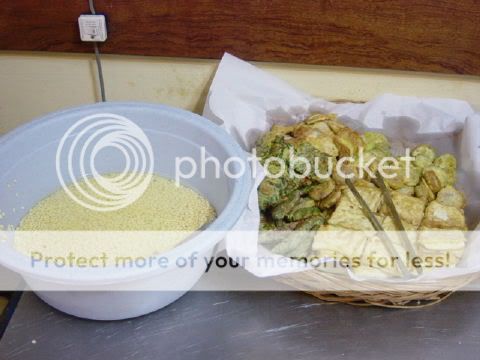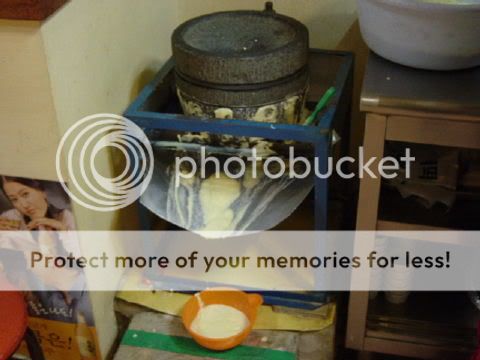I've been craving for bin dae tok (빈대떡) ever since I lost my favourite bin dae tok hangout. So when I found this place, I was excited.
Sidenote : Notice the sign at the top left corner - the one that looks like a flower petal? Well, the sign says "Good Restaurant". You'll find this sign proudly displayed at various restaurants, which I believe is the local system of accrediting restaurants which have passed some sort of "test". Well, the final real test will always be FatMan's burp test.

The set-up is pretty sparse and basic, always a good sign of a restaurant that prides itself in its food and not its decor. There's more tables upstairs.
Looking through the menu on the wall, we have a choice of several types - gogi bindaetok (meat - 고기빈대떡), haemool bindaetok (seafood - 해물빈대떡), yachae bindaetok (vege - 야채빈대떡) and gool bindaetok (oyster - 굴빈대떡). All priced at KRW9,000 each. I ordered the gogi bindaetok, although I had a feeling that their haemool bindaetok was the house special. But I was in the mood for gogi, so there!
They also have pa jeon (파전) in similar variety on the menu. KRW10,000 each.

So what is bindaetok? It's mung bean pancake. Mung what? OK, maybe you know it by its scientific name "phaseolus aureus". No? Still doesn't ring a bell? OK. Try here. Yes?
Here's a bowl of cleaned and soaked beans. Just to be sure, we're talking about the bowl on the left. :o) Sorry I feel cheeky today. The basket on the right is an assortment of vege pajeon.

Here, you won't find any Kenwood blenders. We have 30 years of tradition to uphold after all. A hand-grind mill to turn those mung beans into fine paste.

Here's the assembly line. Left to right : back row - sliced spring onions, whole spring onions; middle row - a plate of oysters, pajeon flour mix and bindaetok mix; front row - pork bacon thinly sliced with fresh sliced chilis, kimchi, seafood mix of octopus, squid and prawns with shredded carrot and leek.
I think that's the main difference between a pajeon and a bindaetok. Pajeon uses plain flour whereas bindaetok uses mung bean. Therefore, the resulting texture is different.

Spread a little flour mix onto the hot pan. The pair in the front is bindaetok and the single at the back is a pajeon.

Load the topping. For the haemool (seafood) pajeon at the back, its the seafood mix + strings of whole spring onions. For the gogi (meat) bindaetok, its the meat mix + kimchi.

Flip. Almost done.

Ahh ... my gogi bindaetok. KRW9,000. Come to papa.

Here's the dipping sauce - soya sauce, onions, chili powder and vinegar. It's a salty sourish combo that I feel is essential to enhance the flavour.

As you can see, inside you'll find a good mix of kimchi, thinly sliced pork, sliced chili and sliced spring onions.


I like bindaetok because the texture of the pancake is really light and fluffy. Unlike the pajeon which can be a little starchy and chewy, bindaetok is so crumbly and literally just melts in your mouth. This place serves a very decent bindaetok. Is it the best? Let's just say my hunt for the ultimate bindaetok continues.
No comments:
Post a Comment